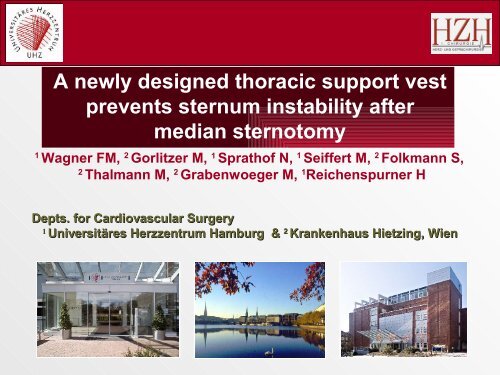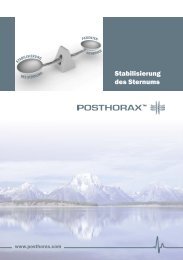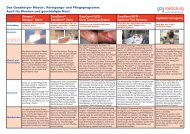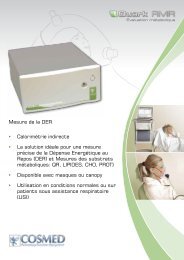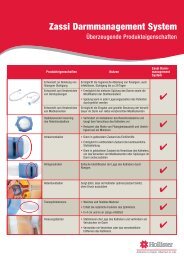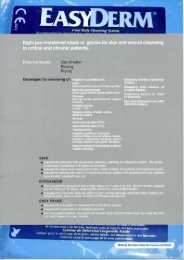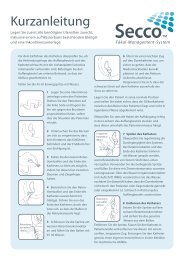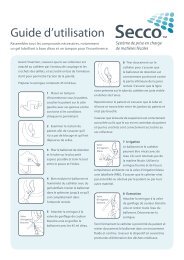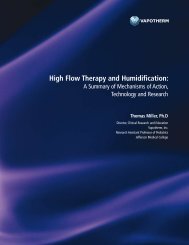A newly designed thoracic support vest prevents ... - gd medical AG
A newly designed thoracic support vest prevents ... - gd medical AG
A newly designed thoracic support vest prevents ... - gd medical AG
Create successful ePaper yourself
Turn your PDF publications into a flip-book with our unique Google optimized e-Paper software.
A <strong>newly</strong> <strong>designed</strong> <strong>thoracic</strong> <strong>support</strong> <strong>vest</strong><br />
<strong>prevents</strong> sternum instability after<br />
median sternotomy<br />
1 Wagner FM, 2 Gorlitzer M, 1 Sprathof N, 1 Seiffert M, 2 Folkmann S,<br />
2 Thalmann M, 2 Grabenwoeger M, 1 Reichenspurner H<br />
Depts. for Cardiovascular Surgery<br />
1 2 Universitäres Herzzentrum Hamburg & 2 & Krankenhaus Hietzing, Wien
120<br />
100<br />
80<br />
60<br />
40<br />
20<br />
0<br />
Deep sternal infection: up to 5%<br />
Mortality ~ 25%<br />
Prolonged hospital stay<br />
Estimated additional cost 2.8 times higher<br />
Braxton et al.: Postoperative survival rate after mediastinitis<br />
Observation Period: 4 years - 15.906 patients<br />
97<br />
93 95<br />
78<br />
89<br />
30 days 1 year 4 years<br />
Background<br />
69<br />
Without mediastinitis<br />
With mediastinitis<br />
Occurence:<br />
During hospitalization: 4.7 %<br />
30 days postoperative:<br />
6.8%<br />
90 days postoperative: 9.0%<br />
D.Jonkers, T.Elenbaas, F.Nieman, E.Stobberingh<br />
European Journal of Cardio-<strong>thoracic</strong> Surgery 23 (2003) 97-102
To test efficacy and acceptance of a <strong>newly</strong> <strong>designed</strong><br />
thorax <strong>support</strong> <strong>vest</strong> to prevent sternum instability and<br />
infections post sternotomy<br />
<br />
To develop risk score for postoperative sternum<br />
instability and infections<br />
Aim of the Study<br />
Posthorax® sternum <strong>vest</strong> (Epple Inc., Vienna, Austria)
Vest Concept and Design<br />
Anteroposterior compression<br />
Sternotomy<br />
cushions
Vest Concept and Design<br />
- allows normal breathing<br />
- stopps over-extension of the thorax<br />
Coughing pressure: 400-1200 N = 40-120 kg (1)<br />
Coughing velocity: 28,000 cm/s = 800 kmH (2)<br />
(1) (The Mechanism of Syncope after Coughing, E. P. Sharpey-Schafer)<br />
(2) (Biomechanical Comparison of Median Sternotomy Closures, Losanoff et al, 2004)
- Prospective 2-center study<br />
- Central randomization<br />
- 90 day follow-up<br />
- Number of patients: n=2000 n= 2000 calculated<br />
- Current analysis:<br />
Study Design<br />
all. pats with complete follow-up until Jan.09
600<br />
500<br />
400<br />
300<br />
200<br />
100<br />
0<br />
400<br />
Groups<br />
482<br />
Patients<br />
85<br />
Patients<br />
Vest<br />
No Vest<br />
Refused<br />
Sept. 07 – Jan 09:<br />
n = 967<br />
age 68±13 68±13<br />
years<br />
9,6% refused <strong>vest</strong>
Patient Risk Profile<br />
% Group Distribution<br />
80<br />
70<br />
60<br />
50<br />
40<br />
30<br />
20<br />
10<br />
0<br />
Male Female Diabetes COPD Perif.vasc.dis MI Complex Surg Perf 100 min+ Perf 200 min+<br />
Vest Group<br />
Non Vest Group<br />
Refused Vest Group
%<br />
70<br />
60<br />
50<br />
40<br />
30<br />
20<br />
10<br />
0<br />
Operative Data<br />
Group Distribution<br />
CABG CABG+BIMA AKE MKE/R AKE+CABG MKE/R+CABG DKE Aneurysm<br />
Vest<br />
Non Vest<br />
Refused Vest
BMI<br />
40<br />
38<br />
36<br />
34<br />
32<br />
30<br />
28<br />
26<br />
24<br />
22<br />
20<br />
18<br />
16<br />
Box Plot of BMI grouped by Gruppe<br />
Vest ref. Vest no Vest<br />
BMI: KW-H(2,875) = 4.4904, p = 0.1059 Gruppe<br />
Euroscore log<br />
20<br />
18<br />
16<br />
14<br />
12<br />
10<br />
8<br />
6<br />
4<br />
2<br />
0<br />
Risk Score Comparison<br />
BMI Age Weight<br />
Euroscore log<br />
Box Plot of Euroscore log grouped by Gruppe<br />
Vest ref. Vest no Vest<br />
Euroscore log: KW-H(2,200) = 0.0706, p Gruppe = 0.9653<br />
Median<br />
25%-75%<br />
Non-Outlier Range<br />
Median<br />
25%-75%<br />
Non-Outlier Range<br />
PreOP: Alter<br />
100<br />
90<br />
80<br />
70<br />
60<br />
50<br />
40<br />
30<br />
20<br />
Box Plot of PreOP: Alter grouped by Gruppe<br />
Vest ref. Vest no Vest<br />
PreOP: Alter: KW-H(2,1007) = 3.6103, p = Gruppe 0.1644<br />
Total Score<br />
30<br />
28<br />
26<br />
24<br />
22<br />
20<br />
18<br />
16<br />
14<br />
12<br />
10<br />
8<br />
6<br />
4<br />
2<br />
0<br />
-2<br />
STS Score<br />
Box Plot of Total Score grouped by Gruppe<br />
Vest ref. Vest no Vest<br />
Total Score: KW-H(2,972) = 6.1426, p = 0.0464 Gruppe<br />
Median<br />
25%-75%<br />
Non-Outlier Range<br />
Outliers<br />
Extremes<br />
Median<br />
25%-75%<br />
Non-Outlier Range<br />
Gewicht<br />
200<br />
180<br />
160<br />
140<br />
120<br />
100<br />
80<br />
60<br />
40<br />
20<br />
Box Plot of Gewicht grouped by Gruppe<br />
Vest ref. Vest no Vest<br />
Gewicht: KW-H(2,873) = 4.3031, p = 0.1163 Gruppe<br />
For each graph:<br />
Median<br />
25%-75%<br />
Non-Outlier Range<br />
Outliers<br />
Extremes<br />
Box left: Vest<br />
Box middle: Refused <strong>vest</strong><br />
Box right: No <strong>vest</strong>
Prevalence of<br />
Wound Complications<br />
Deep sternal infections, superficial infections, dehiscence<br />
%<br />
3,5<br />
3<br />
2,5<br />
2<br />
1,5<br />
1<br />
0,5<br />
0<br />
0,35<br />
3,17<br />
1,41 1,41<br />
0,88<br />
1 - 4 days 5 - 10 days 11 - 15 days 16 - 30 days 31 - 90 days<br />
Post operative days
Results<br />
90 days follow-up<br />
Non <strong>vest</strong> &<br />
refused group Vest group<br />
Total sternal wound<br />
Complications 6,86 % 0,50 %<br />
Deep sternal wound<br />
complications 4,93 % 0,00 %<br />
Superficial wound<br />
complications 1,41 % 0,50 %<br />
Dehiscence 0,52 % 0,00 %<br />
(no infection)<br />
p < 0,005 Fishers Exact Test
Incidence (%)<br />
º<br />
º<br />
ººCompl<br />
º<br />
Results<br />
90 days follow-up<br />
º<br />
ºº<br />
ºº<br />
p < 0,001 ANOVA group comp.<br />
Refusal reasons:<br />
- Discomfort<br />
- Pain<br />
- breathing obstruction<br />
- aesthetics<br />
Vest carriage:<br />
- 31 ± 10 days
Days OP to Discharge<br />
Box Plot of Days OP to Discharge grouped by Gruppe ohne Ausreißer<br />
24<br />
22<br />
20<br />
18<br />
16<br />
14<br />
12<br />
10<br />
Days OR to Discharge<br />
no Vest ref. Vest Vest<br />
Days OP to Discharge: KW-H(2,909) Gruppe = 1.8076, p = 0.4050<br />
Hospitalization<br />
Mean±SE<br />
Mean±0.95 Conf. Interval<br />
ICU Length of Stay<br />
ICU Aufenthalt<br />
60<br />
50<br />
40<br />
30<br />
20<br />
10<br />
0<br />
Box Plot of ICU Aufenthalt grouped by Gruppe<br />
Vest ref. Vest no Vest<br />
Gruppe<br />
Median Test, Overall Median = 2.00000;<br />
ICU Aufenthalt Independent (grouping) variable: Gruppe<br />
Chi-Square = 5.700729 df = 2 p = .0578<br />
Median<br />
25%-75%<br />
Non-Outlier Range<br />
Outliers<br />
Extremes
Vest acceptance rate >90%, main reason for denial discomfort<br />
The use of the Posthorax® <strong>vest</strong> reduced sternum wound<br />
complications significantly<br />
Highest incidence of wound complication in refusal group<br />
More than 50% of wound complications occurred after<br />
hospital discharge<br />
Significant reduction of re-operations lead to cost<br />
effectiveness<br />
Summary


